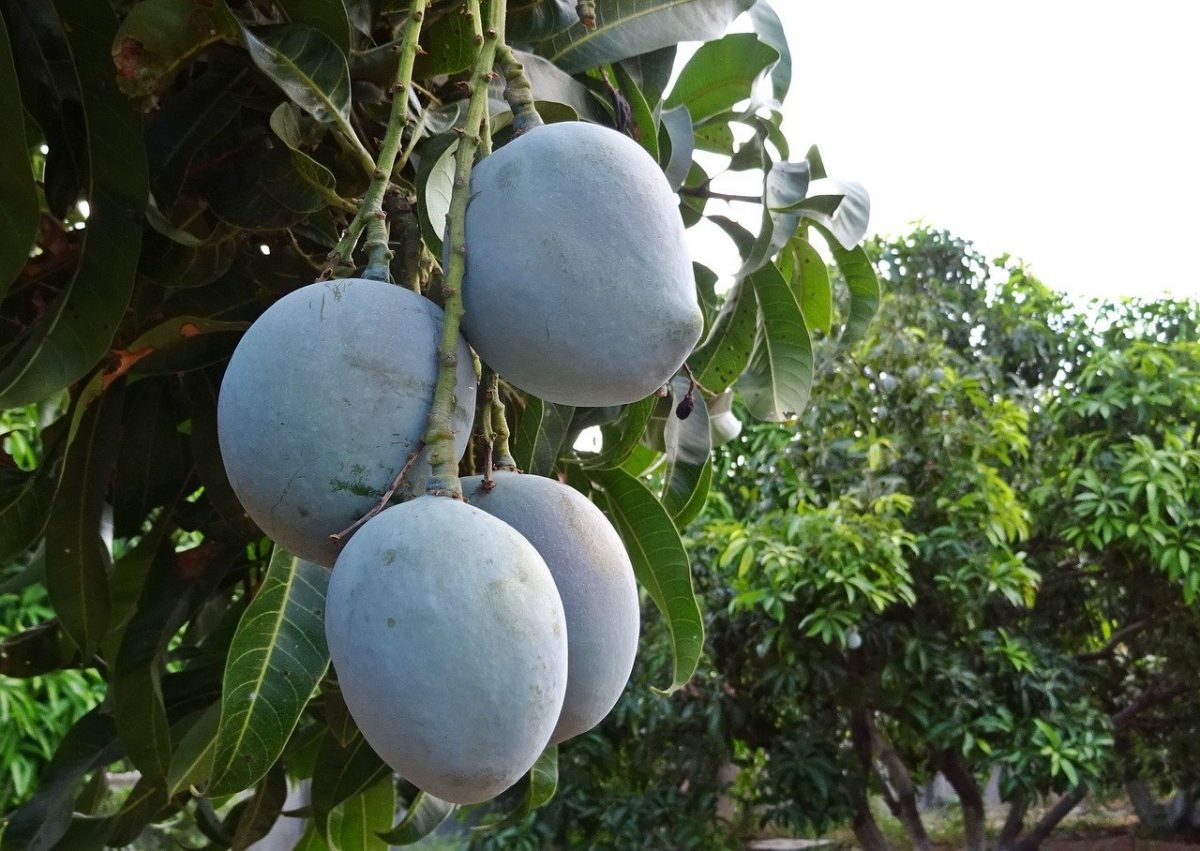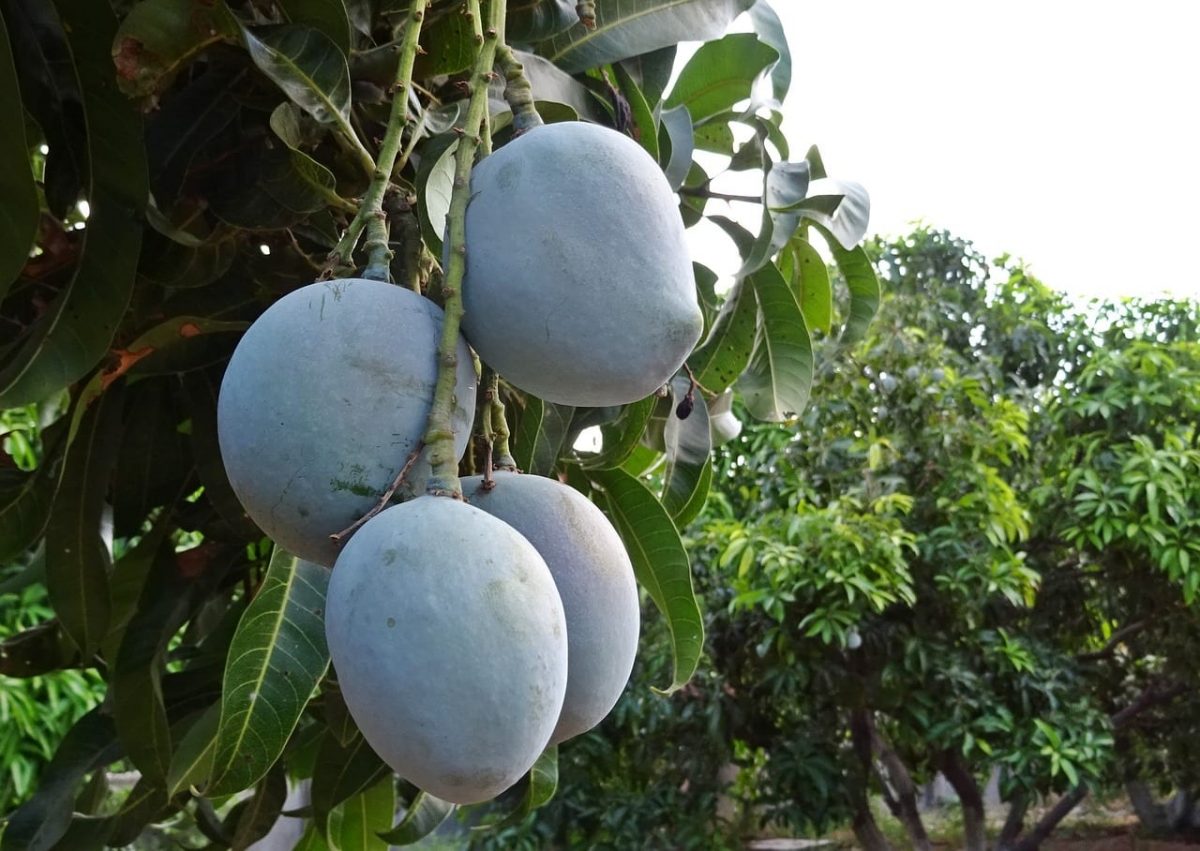
Mango is one of the most popular and loved tropical fruit trees. It produces large fruits, so much so that they can be served as a dinner, and delicious. Precisely because of this when you have one and you don't see it bear fruit, it is not uncommon to worry.
»Why is my mango tree not bearing fruit? What am I doing wrong?are some of the questions we usually ask ourselves. But sometimes it can happen that, simply, we are not making any mistake in its cultivation, but we must wait a little longer.
How long does it take for a mango tree to bear fruit?

Mango is a rather slow growing tree that reaches a height of between 4 and 10 meters, depending on the variety and / or cultivar. It has a more or less wide crown, which provides excellent shade. But it can take a long time to flower and even longer to bear fruit.
If specimen is seed (We can identify it because it has a more or less straight trunk, and does not have the grafted spike), it will spend many of its life developing, so much so that it can take 6 to 15 years to bear fruit. On the contrary, if it is grafted, it will take 2 to 3 years, maximum 4.
Why is my mango tree not bearing fruit?
There are many reasons why a mango does not bear fruit, or stops bearing fruit. Therefore, below we are going to see what they are and what we have to do in each case:
It's very young
As we have commented, depending on whether it is from seed or grafted it may take more or less to bear fruit. But equally, patience is necessary. For one day to produce them, it is crucial to provide adequate care, which is: moderate watering, periodic fertilizers and ... nothing else. It is not a plant that has to be pruned to get fruit; if it's okay, sooner or later it will.
The weather is cold
Although there are varieties and cultivars capable of resisting temperatures of -2ºC, such as Ataulfo, the vast majority do not tolerate such low values. So that they can bear fruit, there must be a minimum annual temperature of 5ºC or higher. In the event that frosts are registered in your area, the ideal is to protect yourself or with anti-frost fabric (for sale here), or if we are talking about really cold climates where frosts are registered several times throughout the winter, we will have to keep it in a greenhouse.

Lack of food (compost)
Sometimes we don't think about it, but the truth is that if we don't fertilize the mango it will cost a lot to bear fruit, especially if the soil we have is poor in nutrients. Thus, from spring to late summer we have to throw it out organic fertilizeras manure or guano (for sale here). We can also mix banana and egg peels, tea bags, and wood ash with the earth.
Need more space
Both to grow and to bear fruit, it needs to be planted in a more or less wide field so that its roots extend as long as they need. The most advisable thing is to plant it far (minimum 4 meters) from other tall plants, in addition to pipes and paved floors.. If you have it in a pot, you have to transplant it to a larger one -about ten centimeters deeper and in diameter than the one you are already using- with mulch, or if you prefer with a substrate for an urban garden. The season of the year in which it will be done will be in spring.
Mango: does it take a male and a female to bear fruit?
It is common to have this doubt, especially since it is a tree that can take a long time to bear fruit. But, as with kakis and citrus, among other fruit trees, the mango is self-fertile. This means that it does not need another specimen nearby to produce fruit, since an individual is only capable of doing so.
How many mangoes does a tree produce?
The number of mangoes on a mature tree is quite high; in fact, in kilos / year, they are about 200, although it can exceed 1000. If we add to that that each fruit can weigh about 400 grams on average, and that it is very nutritious, then we can get an idea of how interesting it is to be in the garden or in the orchard, tasting one before returning to home.
How are mangoes harvested?

Once our mango has borne fruit, how do we have to harvest it? Well then for that you have to know that these take an average of 120 days to finish maturing. We will know if it has done so if, in addition to having acquired the normal color of the variety, when pressing it a little we notice that it is certainly a little tender, but without becoming soft.
Mangoes that are too hard, even if they have their color, will be more difficult to consume since they will not have ripened enough. These can be left in a dry place protected from the sun for a few days, but their thing is not to take them from the tree until they are well, since they do not always mature as expected.
As soon as we have them, we can consume them directly, or leave in the fruit bowl in the kitchen, at room temperature. Another option is to freeze them, but you don't have to keep them in the fridge as they spoil quickly.
We hope that from now on you can enjoy freshly picked mangoes.
I WILL TAKE THE RECOMMENDATIONS YOU GIVE IN THIS BLOG., SINCE I HAVE A GOLDEN MANGO TREE THAT SEMBERED IT 5 YEARS AGO IN THE CITY OF MERIDA YUCATAN MEXICO AND IT HAS NOT BEEN FRUIT AND I AM CONCERNED BUT I ALREADY HAVE TO BE PATIENT., I WILL PUT THE FERTILIZER THAT YOU REVIEW. THANK YOU VERY MUCH FOR YOUR SUPPORT
Hello Jorge.
Surely sooner or later you will get to taste its fruits 🙂
A greeting.
hello I see that it is a good blog.
It turns out that I have mango trees in production but the detail that this year they have not given flower (the keyt mangoes) compared to other lands (orchards) that have the same fruit trees, some chemical to fumigate them and help them give the flower, I cannot apply fertilizers like triple 17 since it is not irrigated land and the rains have ended I hope you can help me I hope a prompt response !!! greetings from nayarit.
Hello Josue.
Rather than spraying them, I would recommend adding powdered compost, such as herbivorous animal manure. You put a layer of a few centimeters thick around the trunk, and mix with the surface of the earth.
This will help them bloom the next season.
A greeting.
Good afternoon!
The problem with my mango is not so much that it does not bear fruit but that it gives little or almost nothing, it began to bloom very early, it filled with flowers and they all withered, until for a while it bloomed again and in abundance but it could only leave us 8 mangoes that I did not taste, now it is blooming almost often before ripening the first fruits are again filled with flowers and leaves a little fruit, actually it does not seem normal to me, its fruits are very huge, we call them popo mango, no I know if that's Spanish but that's what it's called here.
I am writing to you from Equatorial Guinea thanks for the blog and your comments
Thank you
Hi John.
Thanks for your comment. I think you are the first to write to us from Equatorial Guinea, and that we have been since 2011 hehe 🙂
Answering your doubts, from what you count, it may be that your mango is still young (sometimes the young specimens when they begin to bloom, bear little fruit), or that it needs a little help. That help can be in the form of a regular fertilizer during the season with mulch, herbivorous animal manure, or compost, or by planting another mango near it so that the insects pollinate the flowers of both.
If you have more questions, contact us. On this article you have more information about mango.
Greetings.
My mango is quite large planted from seed, about three years ago it gave me the joy of throwing in some quite large and good mangoes, since that year it has not happened again, once the flowers set and soon they fall off, because this happens .
Niger Questions
Hello, can you give me an answer to these two questions? 1) Why are my grafted mango trees after 8 years still not bearing fruit? 2) Can I re-graft these same mango trees to produce mangoes? Thanks in advance for your reply.
Hola!
1.- Are they in a pot or on the ground? If they are potted, they may need more space if they have never been changed. And if they are on the ground, they may need compost.
2.- Yes, of course. But I recommend you wait a bit, and try to solve the cause of why they have not yet borne fruit. Sometimes starting to fertilize a tree or give it more room to grow fixes the problem.
Greetings.
I am very happy because I have a small door in Las Vegas, NV. Your knowledge is very important for my projects.
Hi Agustine.
Thank you very much for leaving us your comment. If at any time you have any questions, please contact us. We will be happy to help you.
Greetings from Spain.